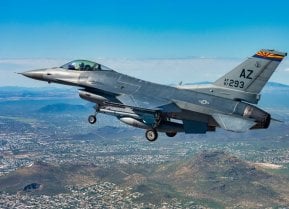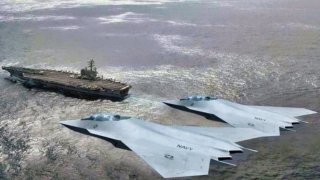Top Gun III Means Maverick Could Fly the F/A-XX Stealth Fighter
If Top Gun III does happen, Tom Cruise could fly the F/A-XX, a new stealth fighter that will someday fly off aircraft carriers for the U.S. Navy.
F/A-XX: What We Know: Tom Cruise has been flying high for the last few years, as Top Gun: Maverick is the big hit of the decade.
While Cruise could be seen in a F/A-18 in the film, should Pete "Maverick" Mitchell return for duty in a possible Top Gun III – some say it unlikely as he'd be into his 60s, but news reports lately seem to indicate it could happen – he might be seen in the cockpit of a F/A-XX, the expected fighter component and centerpiece of the United States Navy's Next Generation Air Dominance (NGAD) family of systems.
The F/A-XX isn't part of the U.S. Air Force's similarly-named NGAD program, however; rather, it is meant to replace the Navy's F/A-18E/F Super Hornet while serving to complement the F-35C beginning in the 2030s.
It was earlier in 2022 that Navy officials suggested the sixth-generation fighter would operate as the service's "quarterback" for manned and unmanned teaming in future carrier operations.
"The NGAD [family of systems] will replace the F/A-18E/F Block II aircraft as they begin to reach the end of service life in the 2030s and leverage Manned-Unmanned Teaming (MUM-T) in order to provide increased lethality and survivability," stated joint testimony from Department of Navy acquisition officials.
"F/A-XX is the strike fighter component of the NGAD FoS that will be the 'Quarterback' of the MUM-T concept, directing multiple tactical platforms at the leading edge of the battlespace."
F/A-XX: A Flying Dorito?
The Navy first lifted the veil on the F/A-XX concept some time ago when the Naval Air System Command (NAVAIR) released the first image of what the future carrier-based fighter might look like.
As reported by Naval News at the time, the illustration of the F/A-XX showed canards and what could be "ruddervator" tailplanes similar to what the YF-23 technology had during the Advanced Tactical Fighter program tests back in the late 1980s. The F/A-XX concept has been described as having a "Dorito-shaped" design.
Though its specific capabilities and technologies are still under development, it is believed the aircraft would have a longer range and greater speed than the F/A-18 Super Hornet, while the future F/A-XX could incorporate passive and active sensor technology, while it possesses the capability to employ longer-ranged weapons as well.
A Component of The Navy's Future Plans
In addition to what we might expect from the aircraft, the United States Navy's future aircraft plans could also be coming into focus. It may not mean the end of the line for the F/A-18 at least until the late 2030s.
Under current plans, the Navy now looks to procure some 230 carrier-based Lockheed Martin F-35C Lightning II fifth-generation fighters – which doesn't actually include the additional short take-off and vertical landing F-35B variant airframes being acquired for the U.S. Marine Corps.
Instead, the service's Navy Aviation Vision 2030-2035 outlines blended carrier air wings, reported Flight Global, that could utilize "a complementary mix" of F/A-18s, F-35s, and the F/A-XX. The report further suggested that the Block III Super Hornet will remain the backbone of the carrier air wing through 2035, with the F-35C acting as a "force multiplier" through the use of its advanced stealth and passive collection intelligence gathering sensors.
In the long-term, the F/A-XX will eventually replace the F/A-18 and serve as that flattop "quarterback." We think Maverick would love it.
About the Author: Peter Suciu
Peter Suciu is a Michigan-based writer who has contributed to more than four dozen magazines, newspapers and websites. He regularly writes about military hardware, firearms history, cybersecurity and international affairs. Peter is also a Contributing Writer for Forbes. You can follow him on Twitter: @PeterSuciu.


